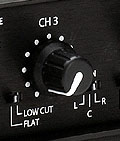Controlling the Input Levels
 On the main face of the mixing panel are four knobs (the correct term is pot or potentiometer), designated as CH 1 thru CH 4. This is where you control the volume or gain of each input.
On the main face of the mixing panel are four knobs (the correct term is pot or potentiometer), designated as CH 1 thru CH 4. This is where you control the volume or gain of each input.
To the right of the four volume controls is the MASTER volume control. The individual volume controls work in tandem with the Master control to give you the total output volume. It is sort of like arithmetic: 3 x 4 = 12, but so does 6 x 2 = 12.
Read the total output gain (volume) on the LED meter display. Avoid going higher than zero. Personally, I would keep conversational dialogue averaging around minus 5, and try to only hit zero on loud outbursts.
A built-in LIMITER will kick in (the LED will light up) when you get way too loud. Limiters act like a pressure valve and prevent the audio from distorting in the mixer. However, some camcorders are more sensitive than others when it comes to hot signals, and may still show signs of distortion or clipping even if the signal stays within industry guidelines. So pay attention to your meter!
Is it better to raise the mic volume and use less master gain, or the other way around? Most of the time, I prefer to keep the pots sort of in the middle, because it is easier for me to physically adjust the knobs up or down during a scene if I am not at either extreme end of the turning range. Technically though, the design engineer of the ENG 44 does say that the quietest results would come from turning the mic levels up so that the master gain is turned somewhat down.
Rolling off the low frequencies
 To the lower left of each knob is a switch indicating FLAT or LOW CUT. FLAT means that the mixer is NOT filtering out any of the low frequencies. LOW CUT means that the mixer is rolling off (reducing) the extreme bass frequencies of the incoming signal.
To the lower left of each knob is a switch indicating FLAT or LOW CUT. FLAT means that the mixer is NOT filtering out any of the low frequencies. LOW CUT means that the mixer is rolling off (reducing) the extreme bass frequencies of the incoming signal.
When listening to music, a lot of bass may be desirable. But when recording audio for film & video, excess low frequencies are the result of ambient noise such as wind and rumble. The excess bass tends to clutter up the soundtrack and makes it hard to understand the dialogue. It is standard practice in Hollywood to filter out the extreme low frequencies when recording voice; but to leave them in for music and special sound effects.
Generally, use the FLAT setting when recording indoors, unless there is background motor hum or air conditioning noise. Outdoors, it is usually better to engage the low cut filter.
Consistency is very important. Use the same filter settings routinely; do not "sometimes" use them and "sometimes not" or else you will find it difficult to intercut your angles later on. You would not want some of your interior shots to be flat (full bass response) at the same time that some matching interior angles had reduced bass. Even if the voices of the actors were not too objectionably different, the room tones and ambiance would certainly change considerably from scene clip to scene clip.
Some users opt to just always leave the low cut switch active, since it is very subtle and sounds okay even for indoor shots.
